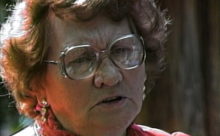Interview with the filmmaker Elva Bishop
Zoe van Buren, Interviewer
ZOE VAN BUREN: How did you get involved with the film?
ELVA BISHOP: Both Cece and Patricia are academics, but at my day job I work for public television, for UNC-TV. And I was a video technician there. But before I’d worked there even, I’d been interested in doing little documentaries however I could. And I’d worked with Cece before on another folklore Arts Council project on Etta Baker, and we worked on another one together but I can’t remember if it was before or after Bessie. We worked on projects funded in the same way as this one.
ZOE VAN BUREN: How did you meet Bessie?
ELVA BISHOP: It was Patricia. Patricia had done all the groundwork really, with Bessie. I think Cece knew her too, but Patricia had developed this wonderful rapport with Bessie, working with her over a long period of time.
ZOE VAN BUREN: What attracted you to working on Bessie’s story?
ELVA BISHOP: She lived in a beautiful place, so it was fun to go up to the mountains to where she lived. That was a plus for sure. But just that kind of subject has been interesting to me, always has been. When I was a kid we spent all our vacations in the North Carolina mountains, so it was what we did.
ZOE VAN BUREN: What was the process of filming and editing like?
ELVA BISHOP: There were lots of facets to what Bessie did and what she knew. Patricia’s big interest was in her repertoire of all of these songs she had learned both over commercial radio and by tradition. So that was a big interest. But she also sang in a church. Her church was very important to her, and her children were very important to her. So there were all these different facets of her life that we touched on, but things like her singing in the church—we recorded a couple of whole church services but we could only use one song. I did the physical editing, pushing the buttons, but Cece worked with me on that. The two of us just chose what we thought stood out the strongest. I loved the setting, both at Bessie’s house and where the church was. There was a little river behind there, and it was all very beautiful. I wanted to give a strong feeling of the place, all around where she lived. I had to do that with cutaways. It wasn’t a travelogue, after all.
Patricia kind of led the way, in that she’d had these conversations with Bessie that had been going on for years at that point. So we would just try to be there as unobtrusively as possible, just recording things. Recording as much as we had time for before Bessie fixed us a wonderful meal everyday. Which was actually the highlight of the whole taping, frankly. It was really good.
One other thing that I’d like to say, is I just remember Bessie’s warmth as a person. She was just such an outgoing, loving kind of person. She just took us in. I felt totally comfortable there, totally welcome. There was no wariness there, like “What are you all doing?” She was just up for everything, going along with everything. It was really sweet to be around her.
